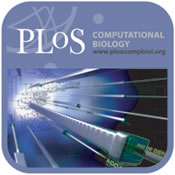|  PLoS Computational Biology PLoS Computational Biology
In June 2010, PLoS Computational Biology celebrates its fifth birthday. The vision of Founding Editors Philip E. Bourne, Steven E. Brenner, and Michael Eisen was to provide “a place where computational biologists can find the best work produced by their colleagues, and where the broader biological community can see the myriad ways computation is advancing our understanding of biological systems.” We believe that the breadth and quality of the articles we publish, as well as our ongoing involvement in numerous additional community-focused projects, evidence real fulfillment of this vision -- and more on the horizon.
In April 2010, PLoS Computational Biology published its first “Conference Postcards”. We invited young scientists attending the Pacific Symposium on Biocomputing (PSB) 2010 to send us a "Postcard" describing their scientific highlight of the conference. In the article, two graduate students discuss an exhilarating talk by Edward Marcotte; their different approaches highlight the potential of Conference Postcards perfectly. (www.ploscompbiol.org/doi/ pcbi.1000746). We hope that this article will inspire upcoming scientists in the field to describe the highlights of future conferences, the first being the ISMB 2010.
These concise summaries of emerging scientific frontiers are neatly complemented by another series of articles, The Roots of Bioinformatics, the first of which published in June. Edited by David Searls, the series asks key leaders to give a personal perspective on the historical development of different disciplines within computational biology.
April 2010 also saw the launch of our joint venture with PLoS ONE, in the “RECOMB Regulatory Genomics and Systems Biology 2009” collection, which draws together papers from the two RECOMB satellite meetings last December (www.ploscollections.org/ article/browseIssue.action? issue=info%3Adoi%2F10.1371% 2Fissue.pcol.v01.i04).
PLoS Computational Biology maintained its strong tradition of informative Education articles and thought-provoking pieces about the emerging issues in the field. We remain pleased that these articles, some noted below, are well read and highly downloaded as tracked by using PLoS’ new Article Level Metrics, which allow readers and authors to instantly see usage statistics for any published article.
Examples of highly downloaded content:
Structure of Protein Interaction Networks and Their Implications on Drug Design
Hase T, Tanaka H, Suzuki Y, Nakagawa S, Kitano H
www.ploscompbiol.org/doi/pcbi.1000550
Googling Food Webs: Can an Eigenvector Measure Species' Importance for Coextinctions?
Allesina S, Pascual M
www.ploscompbiol.org/doi/pcbi.1000494
Functional Brain Networks Develop from a “Local to Distributed” Organization
Fair DA, Cohen AL, Power JD, Dosenbach NUF, Church JA, et al.
www.ploscompbiol.org/doi/pcbi.1000381
Ten Simple Rules for Choosing Between Industry and Academia
Searls DB
www.ploscompbiol.org/doi/pcbi.1000388
A Quick Guide to Teaching R Programming to Computational Biology Students
Eglen SJ
www.ploscompbiol.org/doi/pcbi.1000482
As ever, we are aware that the journal’s success is dependent on the hard work and dedication of, and the donation of time and expertise by, the community, and we are grateful to all of you for your support.
 |

